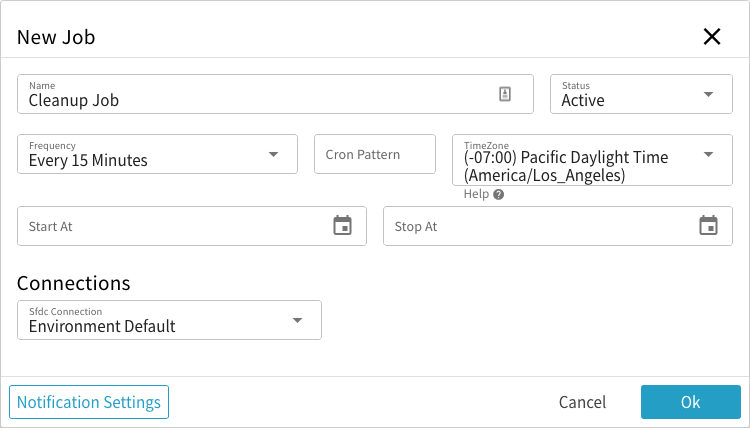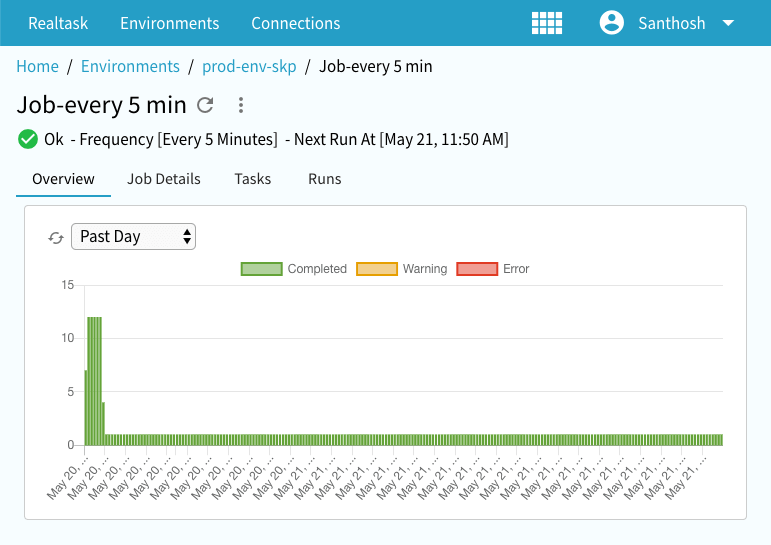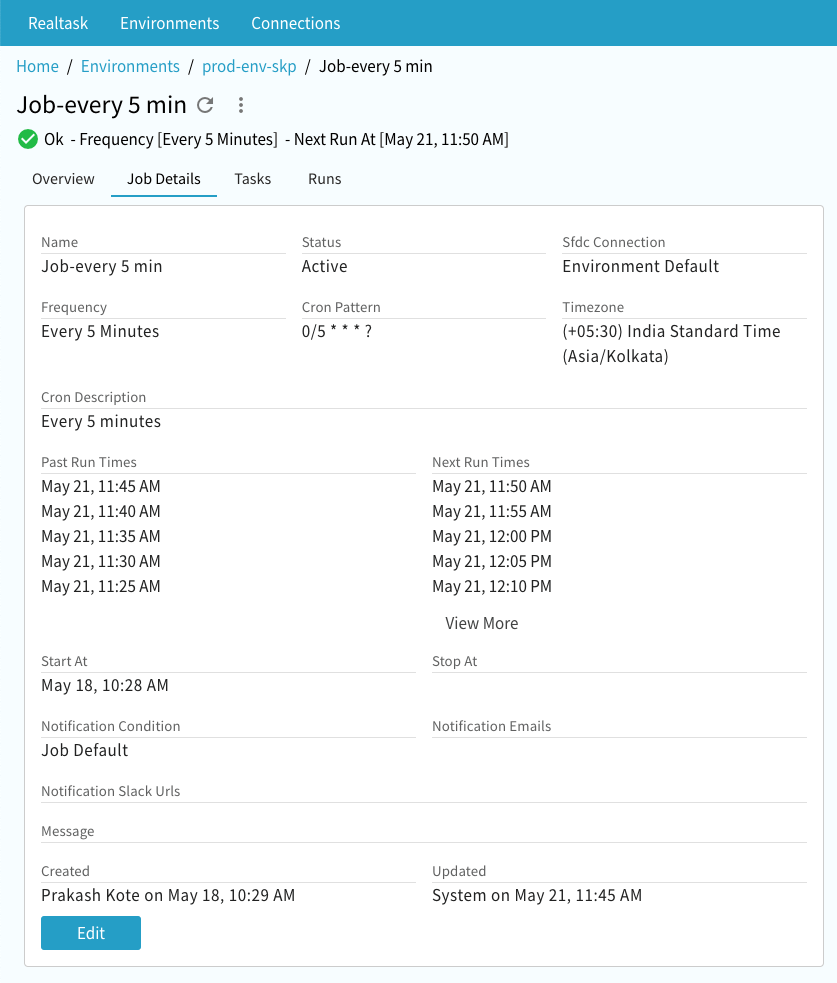Job
Job represents set of tasks that needs to be executed on demand or at a particular time.
For example., it could be
Cleanup Old Tokensjob that runs every day at 1am to delete any old Tokens.Standardize Addressjob that runs every 5 minutes, and processes all accounts which are created in last 5 minutes
Job belongs to an Environment and consists of one or more Tasks. A Job can be executed manually any time or scheduled to be executed at a time, either for one time or repeated execution at Frequency of your choosing. We support many pre-defined Frequencies or full Cron expression with special flags.
When a Job is executed, it creates a Run and that run becomes part of Run history which you can access and view to understand the past history.
Job can be inactivated and when it is inactivated, it will stay in the system but it will not be executed. However, all the config, run history stay put as is, so you can come back and re-activated.
List Jobs
To view the Jobs, click on the Environments menu item and select the Environment whose Jobs you want to manage. If you
are
authorized to Manage Jobs, you can create/edit Jobs.
New Job
To create new Job, click on the + icon in the Jobs Data Grid. It should bring you to following dialog.

Here is more information about each of the fields in this dialog.
| Field | Description |
|---|---|
| Name | Name for this Job. It should be succinct and short as it will be included in the Reports and Notifications. |
| Status | Status of the Job. If it is Inactive then this Job will not be executed |
| Frequency | The interval when this Job should be executed. See Frequency section below for more info. |
| Cron Pattern | If the Frequency is Cron then specify the Cron Pattern. If Frequency is not Cron, then this field managed automatically by the application. |
| Timezone | Timezone of the Job. See Timezone section below for more info |
| Start At | Indicates the Date/Time when at which this Job becomes eligible for execution. See section Time-bound Execution below for more info. |
| Stop At | See section Time-bound Execution below for more info. |
| Connections | If you want to use different Connections for Tasks in this Job, you can specify here. Otherwise, it will be defaulted to what is specified at this Job's Environment |
| Notification Settings | Use this dialog to configure Notification Settings for this Job. If not specified, defaults to Environment level Notification Settings |
Once a Job is added, you will be taken to Job page which allows you to configure Tasks.
Edit Job
Job can be edited by selecting the Edit Icon in the Job which you want to edit. You can also click on the Edit Job
button in the Job Details Tab in Job page.
Edit Job shows the same Dialog as New Job. See that section for more information about Fields.
If you change the Frequency or cron pattern, it will be effective after completing the in-progress executions. ::
Delete Jobs from Data Grid
You can select one or more Jobs and click Delete Icon. System will ask you to confirm the deletion. Upon confirmation, it will take following actions.
- Jobs will be deleted
- All Run history of deleted Jobs will be deleted
- Any log files associated with the deleted Jobs will be deleted
- Confirmation message will be shown in the UI
- Data Grid will be refreshed with current Jobs
Delete Job from Job Page
Job can also be deleted from Job page. To delete select More Options menu and select Delete Job menu item.
System will prompt you to confirm the deletion and if chosen, will delete the Job and take you back to Jobs list page.
Job Frequency
Job Frequency indicates the interval when a Job needs to be executed. Below are the various Frequencies that you can choose from.
| Frequency | Description |
|---|---|
| Manual | Job will be executed when requested to run. |
| One Time | Job will be executed one time. Time of execution must be specified as Start At field. After one execution, it will not be executed again until new time is specified or frequency is changed. |
| Cron | Job will be executed at interval specified by Cron Pattern. We use cronjs a open-source library from Datasert to parse the expressions. Please see its home page for more info. If you are not sure, please reach out to us. |
| Every Minute | |
| Every 5 Minutes | |
| Every 10 Minutes | |
| Every 15 Minutes | |
| Every 20 Minutes | |
| Every 30 Minutes | |
| Every Hour | Every hour at minute 0 |
| Every 15 Past Hour | |
| Every 30 Past Hour | |
| Every 45 Past Hour | |
| Every 2 Hours | |
| Every 3 Hours | |
| Every 4 Hours | |
| Every 6 Hours | |
| Every 8 Hours | |
| Every 12 Hours | |
| Every Day | Every day night at 12 mid |
| Every Monday Night | |
| Every Tuesday Night | |
| Every Wednesday Night | |
| Every Thursday Night | |
| Every Friday Night | |
| Every Saturday Night | |
| Every Sunday Night | |
| Every First Monday of Month | |
| Every Last Friday of Month | |
| Every First Day of Month | |
| Every 15 Day of Month | |
| Every Last Day of Month | |
| Every First Weekday of Month | |
| Every Last Weekday of Month | |
| Every First Day of Quarter | |
| Every Last Day of Quarter | |
| Every First Weekday of Quarter | |
| Every Last Weekday of Quarter | |
| Every First Day of Year | |
| Every Last Day of Year | |
| Every First Weekday of Year | |
| Every Last Weekday of Year | |
| Every First Monday of Year | |
| Every Last Friday of Year |
Job Timezone
If Job needs to be executed at a repeated interval at certain time of the day, then that time of day is interpreted according to this timezone.
For ex., if you say, Job needs to be executed at 1 am, which 1 am? is it when it is 1am in London or San Francisco or Bangalore? Timezone tells the system which time of the day to use. When you create a new Job, it is defaulted to user's Timezone.
Job Timezone can be changed any time and run times will be re-calculated based on the new Timezone.
Run Job from Data Grid
To run one or more Jobs, select the Jobs in the Data Grid, click on the More Options Icon in the Data Grid toolbar and
select Run Jobs menu item.
System will prompt you to confirm and upon confirmation it will be marked for execution.
::: tip Note that it can take upto a minute to execute a Job :::
Run Job from Job Page
To run the Job from Job page, click on the More Options Icon next to Job name and chose Run Job.
View Job
If you want to view more details about a Job or if you want to manage its Tasks, you need to be in Job page.
To goto Job page, click on the Job name hyperlink in the Jobs list. Or you can also bookmark the url of that Job page and access it directly.
Job Page
Job page shows complete information about a Job including its details, Tasks and Run History. It can be accessed from Jobs list page or by entering the Job url directly.
Here is the basic layout of Job page.

Job page show brief summary of Job which
includes {Job Status} - Frequency [{Job Frequency}]- Next Run At [{Next Run Time}].
Tab strips shows following tabs.
| Tab | Description |
|---|---|
| Overview | This tab shows the chart of Job execution to get a essence of a Job and its performance. |
| Job Details | This tab shows the details of Job like its frequency, past run times, future run times etc., |
| Tasks | This tab shows the Job Tasks and allows you to manage them |
| Runs | This tab shows the Job Runs |
Job page has a couple of icons next to Job name as follows.
Refresh Iconallows you to refresh the Job. When Job is refreshed, its tasks as well as its Runs will also be refreshed.More Options Iconshows you a menu with few options to Edit, Delete and Run Job.
Job Overview Tab
Job overview tab shows the Graph of all executions of this Job upto 6 months in the past. Job execution times of past week are exactly same upto second but after week, they are aggregated to hour level if there are more than few runs in that hour. This would impact only Jobs that are run every minute.
By default, filter shows the executions for past day. You can change the time range using drop-down for upto past 6 months.
Job Details Tab
Job Details tab shows the all necessary details related to current Job. It looks as follows.

Most of the fields must be familiar as are just what you specified while creating/updating the Job. However there are few fields which are derived and new to this section which are explained below.
| Field | Description |
|---|---|
| Cron Description | Any time you enter cron description, we convert that cron description into readable text and display here. This also shows the description for pre-defined Frequencies which are cron based. |
| Past Run Times | This field shows the last 5 past execution times |
| Next Run Times | If this job is scheduled to run, then this shows upto 5 future execution times |